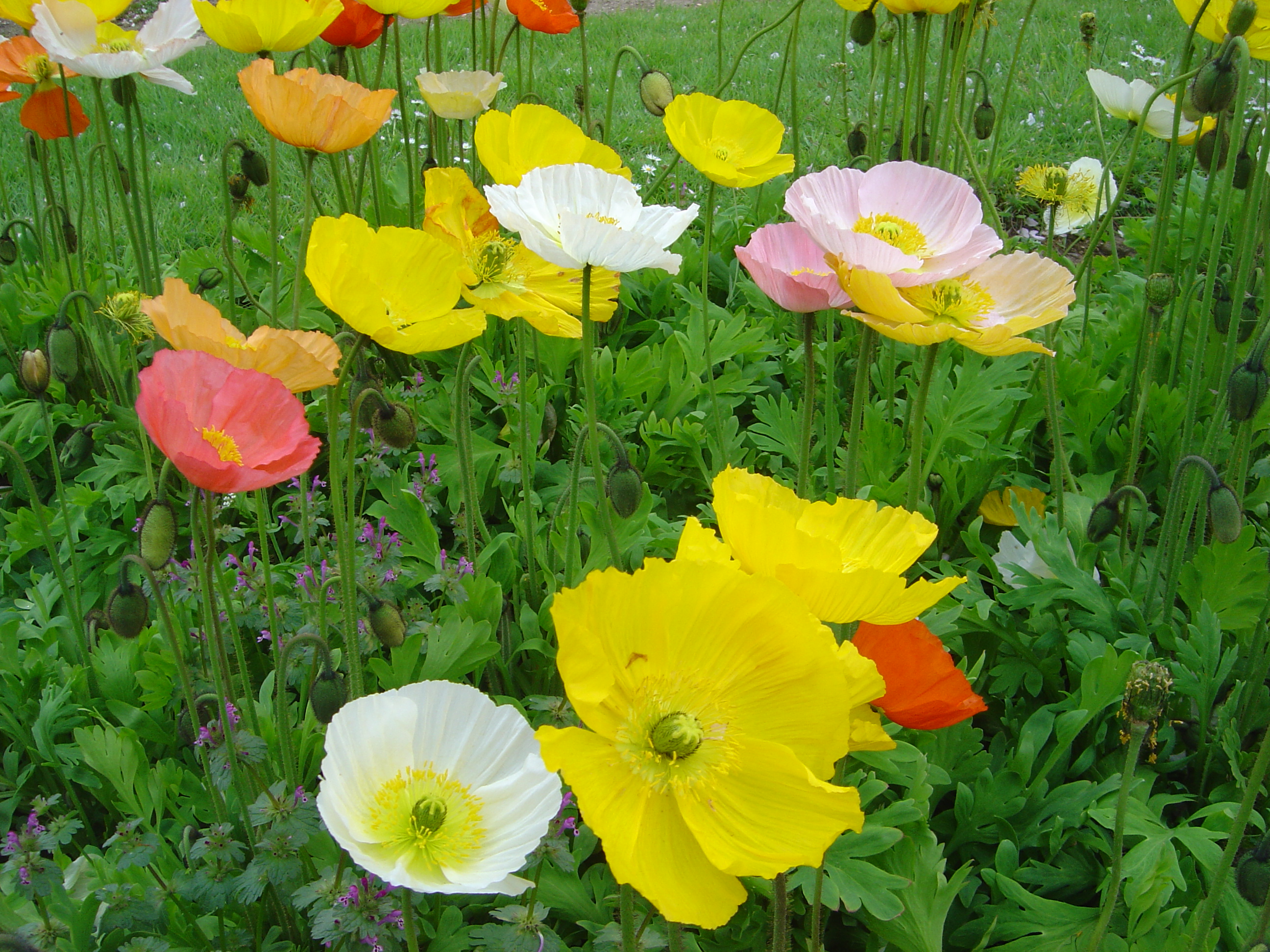- Iceland poppy
Taxobox
name = Iceland Poppy

image_width = 250px
image_caption = Icelandic Poppy ("Papaver nudicaule")
regnum =Plant ae
divisio = Magnoliophyta
classis =Magnoliopsida
ordo =Ranunculales
familia =Papaveraceae
genus = "Papaver "
species = "P. nudicaule
binomial = "Papaver nudicaule"
binomial_authority = L.The Iceland Poppy ("Papaver nudicaule" syn. "Papaver croceum, P. amurense, P. miyabeanum", and "P. macounii") is a
boreal flowering plant. Native to subpolar regions of northern Europe and North America,Iceland poppies are hardy but short-lived perennials,grown as biennials, that yield large, papery, bowl-shaped, lightly fragrant flowers supported by hairy, 1-foot, curved stems among feathery blue-green foliage 1-6 inches long. They were first described by botanists in 1759. The wild species blooms in white or yellow, and is hardy from USDA Zones 3a-10b. All parts of this plant are likely to be poisonous [Kingsbury, J. M. (1964) Poisonous plants of the United States and Canada. Prentice-Hall Inc., Englewood Cliffs, N.J., USA. pp. 626] , containing (like all poppies) toxic alkaloids. In particular, "P. nudicaule" has been shown to contain the benzophenanthidine alkaloid,chelidonine . [Zhang, Y., Pan, H., Chen, S., Meng, Y., Kang, S. (1997). [Minor alkaloids from the capsule of "Papaver nudicaule" L.] Zhongguo Zhong Yao Za Zhi 22: 550-1, 576. In Chinese.]Varieties
Cultivar s come in shades of yellow, orange, salmon, rose, pink, cream and white as well as bi-colored varieties. Seed strains include: ‘Champagne Bubbles’ (15-inch plants in orange, pink, scarlet, apricot, yellow, and creamy-white); ‘Wonderland’ (10-inch dwarf strain with flowers up to 4 inches wide); ‘Flamenco’ (pink shades, bordered white, 1 1/2 to 2 feet tall); ‘Party Fun’ (to 1 foot, said to bloom reliably the first year in autumn and the second spring); ‘Illumination’ and ‘Meadow Pastels’ (to 2 feet, perhaps the tallest strains); ‘Matador’ (scarlet flowers to 5 inches across on 16 inch plants); and ‘Oregon Rainbows’, which has large selfed, bicolor, and picoteed flowers and is perhaps the best strain for the cool Pacific Northwest [Sunset Publishing (2001) "Sunset Western Garden Book, ed. 7" (Sunset Books Incorporated: ISBN 0-37603-874-8)] (elsewhere this strain’s buds frequently fail to open).Cultivation
The plants prefer light, well-drained soil and full sun, but the plants are not hardy in hot weather, perishing within a season in hot summer climates.
Iceland poppies, like all poppies, possess exceedingly minute seeds and long taproots that resent disturbance. So the seeds are best sown outdoors in autumn (or, at the very latest, in earliest spring) where you wish them to grow, in a reasonably well-drained soil. In mild winter climates, start Iceland poppy seeds indoors and transplant seedlings into their desired positions when they are 2-4 inches tall. The strongest plants are autumn-sown. In cool summer climates on well-drained soils, Iceland poppies can live 2-3 seasons, flowering from early spring to fall [Armitage, Allan M. (2001) "Armitage’s Manual of Annuals, Biennials, and Half-Hardy Perennials" (Timber Press; ISBN 0-88192-505-5)] .
To germinate Iceland poppy seed inside, fill peat or paper pots with barely moistened sowing medium. Contrary to many books’ advice, it is not necessary to give them cold-treatment; Dr. Norm Deno’s experiments with Iceland poppy seeds showed that they germinate readily at 70ºF. Just press the seeds into the surface of the soil, sprinkle a small amount of sand or vermiculite over them, and spritz to moisten. Don’t let the pots dry out (try placing each peat or paper pot in a plastic bag, loosely tying the bag shut at the top or half-zipping it closed, to allow the medium to breathe). Place the pots in a warm spot out of direct sunlight, otherwise their contents will cook; if you have a heat mat, it will hasten germination. When the seedlings show, move the pots into the best light you can give them until the ground can be worked in spring. Do give them plenty of room: 9-12 inches apart. Crowding will give you spindly plants.
If you decide to confine your poppies to pots ('Champagne Bubbles' is a good strain for this), be sure to use a well-drained medium. Keep seedlings evenly moist, but once the plants get 4 inches or so tall, water only when the surface of the soil is dry to the depth of your first knuckle. Fertilize weekly with a plant food that is not too high in nitrogen (such as 5-10-5). Inside or out, when your plants begin to bloom, remove the fading flower-stems at the base, for if you let the plants go to seed, it will greatly reduce their longevity.
Iceland poppies are amongst the best poppies for cutting, lasting several days in the vase if they are cut just before the buds open and the stem-ends are seared for ten seconds in a flame or boiling water so that their white latex doesn’t leak out.
Genetics of iceland poppy
The garden forms of "P. nudicaule" have been studied genetically, particularly with respect to flower colour [Fabergé, A.C. (1942) Genetics of the scapiflora section of "Papaver" 1. The Garden Iceland Poppy. "Journal of Genetics" 44: 169-193.] . The white flower colour is dominant with respect to yellow. Other colours, such as buff and orange, are recessive.
References
Wikimedia Foundation. 2010.
